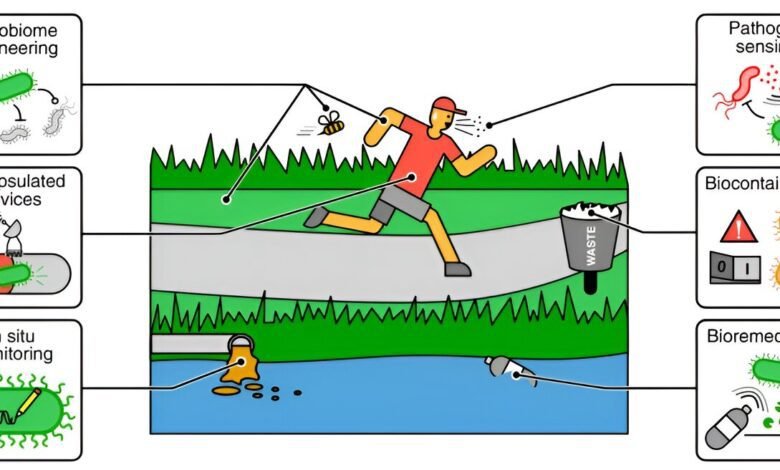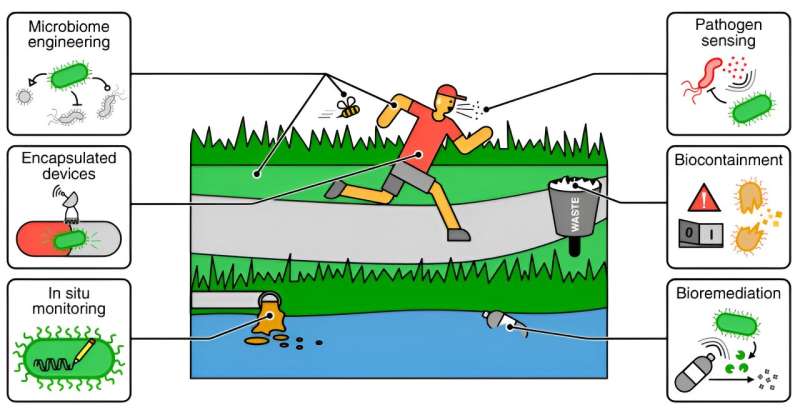Improving accuracy and adaptability in genetic sensor technology


Genetic sensors improve ecosystems, monitor health, ensure safety and recycle waste through bioremediation pathways. Credit: Biodesign Research
Genetic sensors play a crucial role in organisms by regulating gene expression in response to environmental stimuli. Despite its importance, its development is hampered by challenges such as slow growth rates in the source organisms and limitations in precision and sensitivity.
Previous studies have aimed to harness these natural sensing capabilities to address pressing global challenges such as food security, sustainable production, diagnostics and healthcare. These efforts underscore the importance of advancing genetic sensor technology to increase its efficiency and applicability in various fields.
In a recent study led by Dr. Thomas Gorochowski, researchers pushed the boundaries of genetic sensor technology. This review, published in the magazine BioDesign Research on June 25, 2024, identified more efficient and versatile biosensors, capable of detecting a broad spectrum of substances with high specificity and sensitivity.
Reflecting on his work, Dr. Gorochowski emphasized, “As synthetic biology solutions advance toward real-world applications, the incorporation of advanced sensing and control mechanisms will be essential to ensure their safe and reliable deployment.”
His research methodology has focused on exploring diverse genetic sensor architectures, each designed to improve sensitivity and specificity for a variety of applications. At the heart of his study are protein-based sensors, which bind directly to target molecules, influencing gene expression.
These sensors operate through single-component systems, where a solitary protein detects the target, and two-component systems involving a histidine kinase sensor and a response regulator. This dual approach ensures strong sensing capabilities tailored to specific environmental or biomedical targets.
RNA aptamers represent another essential aspect of the study, located in the 5′-UTR of transcripts. These aptamers form intricate structures that hinder translation by binding to specific target molecules. Recognized for their versatility in detecting a broad spectrum of targets with high specificity, RNA aptamers are indispensable tools in genetic sensor technology, offering precise control over the dynamics of gene expression.
His research also included innovative synthetic approaches that significantly improved sensor capabilities. Techniques such as Sensing Enabled by Metabolic Pathways (SEMP) have been deployed to design synthetic metabolic pathways capable of converting target molecules into detectable forms.
At the same time, Toehold switches (THS), using synthetic RNA structures, regulated translation in response to specific RNA targets. Furthermore, the adaptation of CRISPR-Cas systems for RNA detection has provided unprecedented control over gene expression, highlighting the versatility and adaptability of their synthetic strategies.
In addition to the diversity of sensor types explored, the integration of genetic sensors with light and electrical signals represents a significant advance in technology. This innovation allows precise control over the dynamics of gene expression, leveraging electronic and optical devices to expand the capabilities of genetic sensors in diagnostics and environmental monitoring. By merging biological systems with these technologies, the research team has expanded the scope of genetic sensor applications, promising transformative impacts across scientific disciplines.
The findings of this research have significant implications, particularly in reshaping healthcare diagnostics, environmental monitoring, and biotechnology applications.
With the development of more efficient genetic sensors, there is an increase in their precision and flexibility, suggesting a future where these sensors will assume critical roles in personalized medicine, sustainable resource management and industrial biotechnology. This progress promises to revolutionize the way we detect diseases, monitor environmental health and optimize industrial processes, paving the way for advances that respond to diverse global challenges.
In conclusion, this review highlights the transformative potential of genetic sensor technology. By unraveling the complexities of sensor development and deployment, the study lays a solid foundation for future innovations in synthetic biology and biomedical engineering.
Dr. Gorochowski highlighted the importance of his work, stating, “Control processes in synthetic biology are already emerging, and further integration of control engineering principles into the design of genetic sensors is crucial for their widespread deployment in everyday applications.”
This forward-looking approach not only advances scientific understanding, but also sets the stage for practical applications that address complex challenges in healthcare, sustainability, and industrial processes.
More information:
Shivang Hina-Nilesh Joshi et al, Accelerating the development, scale-up and deployment of genetic sensors using synthetic biology, BioDesign Research (2024). DOI: 10.34133/bdr.0037
Provided by Chinese Academy of Sciences
Quote: Improving Accuracy and Adaptability in Genetic Sensor Technology (2024, July 1) retrieved July 1, 2024 from
This document is subject to copyright. Other than any fair use for private study or research purposes, no part may be reproduced without written permission. Content is provided for informational purposes only.




